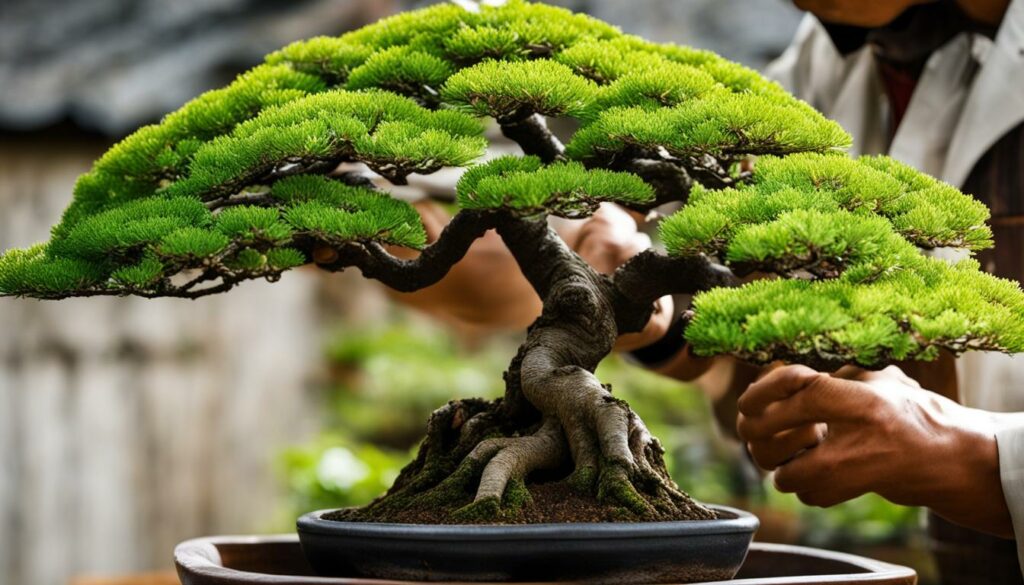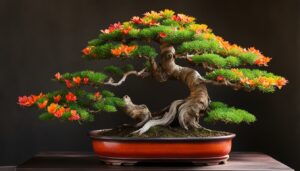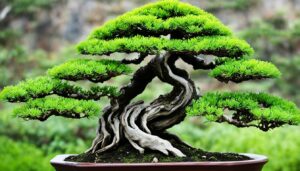If you have a passion for beautiful, miniature trees, you know that bonsai is more than just a hobby – it’s an intricate art form that requires patience, skill, and dedication. As you cultivate your bonsai, one of the most important techniques to master is pruning. Bonsai styling pruning is essential for shaping the tree to your desired aesthetic, controlling growth, and ensuring long-term health.
In this comprehensive guide, we will cover everything you need to know about pruning bonsai trees. From understanding pruning techniques and tools to balancing growth and pruning, we will provide step-by-step instructions, tips, and tricks for maintaining your bonsai’s beauty and vitality. Whether you’re a beginner or an experienced grower, this guide will take your bonsai pruning skills to the next level.
Key Takeaways:
- Bonsai styling pruning is crucial for shaping a bonsai tree to your desired aesthetic while promoting and maintaining its health.
- Pruning techniques, tools, and timing vary depending on the type of bonsai tree you have and its stage of growth.
- Strategic branch and foliage placement, along with wiring, can help create movement, balance, and proportion in the bonsai’s overall design.
- Regular pruning promotes airflow, reduces pests and diseases, and aids in the tree’s overall well-being.
- Aftercare, maintenance, and troubleshooting are essential steps in ensuring the ongoing health and beauty of your pruned bonsai tree.
Understanding Bonsai Styling Pruning
If you’re serious about bonsai tree care, you’ll need to become an expert in bonsai styling pruning. This technique involves selectively removing branches and foliage to shape the tree into the desired form, enhancing its aesthetic appeal and health.
Bonsai styling pruning is not a one-time process; it requires consistent attention and care to maintain the desired shape. However, proper execution of the pruning process results in a healthy and visually appealing tree that stands the test of time.
When it comes to bonsai styling pruning, there are several aspects to consider. First, branch selection is crucial. You need to trim away unwanted branches to expose the best branches, which will serve as the foundation for the tree’s overall shape. Second, branch structure is important to maintain balance and proportion in the tree’s design. Finally, foliage density is essential in promoting healthy growth and preventing disease.
Not sure where to start with bonsai styling pruning? Consider consulting with a professional or investing in a bonsai pruning guide to help guide your technique and provide tips and tricks for success.
| Bonsai Styling Pruning Tips | Tree Care | Shaping Bonsai |
|---|---|---|
| Choose strong branches to maintain the tree’s shape. | Regularly water and fertilize your bonsai tree to promote healthy growth. | Use wire to help bend and shape branches to desired positions. |
| Balance the pruning of roots with pruning of branches to avoid stressing the tree. | Avoid overwatering, as this can lead to root rot and subsequent death of the tree. | Focus on creating movement and balance in the tree’s design through strategic placement of branches and leaves. |
| Don’t be afraid to experiment with different shaping techniques to achieve unique and artistic effects. | Regularly inspect your bonsai tree for pests and disease to catch issues early on. | Be patient with the pruning process and take your time to avoid damaging the tree. |
Now that you understand the importance of bonsai styling pruning, it’s time to get started on this essential technique. With some practice and patience, you’ll be well on your way to creating beautiful, healthy bonsai trees that will last a lifetime.
Tools for Bonsai Pruning
To properly care for your bonsai tree, you’ll need a few essential tools. Here are the tools you’ll need:
| Tool | Use |
|---|---|
| Shears | To cut small branches and leaves |
| Concave cutters | To make flush cuts and promote healing |
| Wire cutters | To cut and remove wire used for shaping and positioning branches |
When selecting pruning tools, it’s important to consider the quality and sharpness of the blades. Dull blades can crush the plant tissue, making it harder for the plant to heal after pruning. You should also keep your tools clean to prevent the spread of disease between trees.
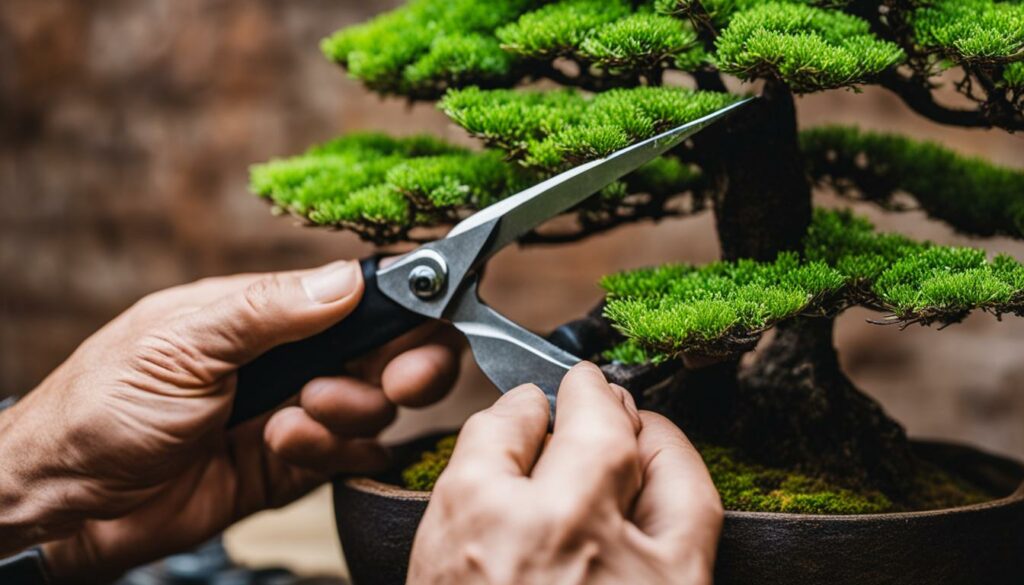
With the right tools and maintenance, you can properly prune your bonsai tree for its health and aesthetic appeal.
Pruning Techniques for Bonsai Trees
Pruning is one of the most important techniques in bonsai styling pruning and tree care. It helps to shape and maintain the health of the bonsai tree. There are several pruning techniques that are commonly used in bonsai tree care.
Tip Pruning
This technique involves the removal of the terminal bud at the tip of a branch. It helps to create a bushier tree and restricts the growth of the tree.
Branch Pruning
This is the most common type of pruning used in bonsai styling pruning, and it involves the selective removal of branches to improve the general appearance of the tree. You can remove entire branches, shorten them, or cut back to a lateral bud.
Root Pruning
This technique is used when the roots of the tree have outgrown the pot. Root pruning involves the selective removal of large anchor roots to improve the root system’s overall health.
Regardless of the pruning technique you use, it’s essential to know how to execute them properly. Improper pruning can damage your tree, so it’s important to use the right tools and techniques.
When pruning, hold the branch properly and use sharp, high-quality shears or cutters. It’s important to cut at a 45-degree angle to prevent the bark from tearing. After pruning, apply wound paste to protect the tree from pests and diseases. Finally, do not remove more than 25% of the foliage at once, as this may cause stress to the tree.
Pruning is an essential part of bonsai styling pruning and tree care. By learning to execute the different pruning techniques properly, you can shape your bonsai tree and maintain its health for years to come.
Branch and Foliage Placement
As you start mastering the art of bonsai styling pruning, you’ll soon discover how crucial strategic branch and foliage placement is for achieving the desired look of your tree. Proper placement is essential to creating balance, proportion, and movement within the bonsai design.
Branch placement should be carefully observed to ensure that branches don’t cross or interfere with each other. Branches should also be positioned to reflect the natural growth pattern of the tree, creating a lifelike appearance. To create depth and movement, you can position branches at different angles and lengths.
Foliage placement is also an important consideration for bonsai trees. The foliage should be evenly distributed to maintain the tree’s symmetry and balance. During pruning, you must also maintain the foliage density, ensuring that the tree has enough foliage to sustain its growth and health.
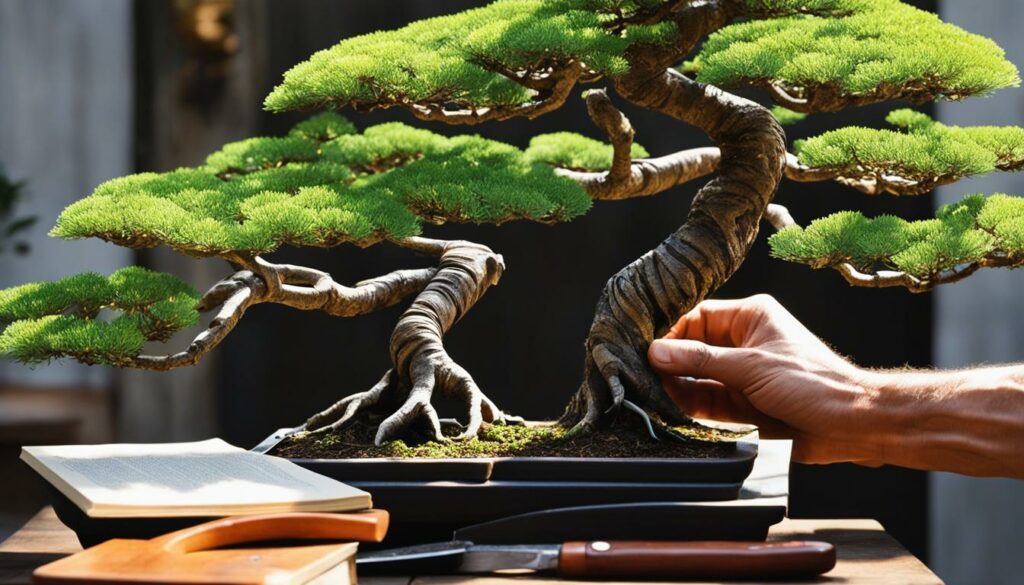
Using the right tools for pruning can make Branch and Foliage Placement and styling much more manageable to achieve.
Tip: Researching the growth patterns and natural habitat of your chosen tree species can provide valuable insight into deciding the optimum position for branches and foliage.
Balancing Growth and Pruning
When it comes to bonsai tree care, pruning techniques play a crucial role in shaping your tree’s growth pattern and maintaining its shape and overall health. Tree care attempts to strike the right balance between pruning and promoting healthy growth, which takes careful observation and adjustments to ensure the perfect conditions for your Bonsai trees.
Pruning and styling are necessary components of maintaining a bonsai tree, but overdoing either of them could cause the tree to lose its aesthetics and deteriorate. To counteract this, you must know the right timing and frequency of pruning required to keep your tree healthy and shaped.
Timing and Frequency of Pruning
Pruning should be done after the tree has completed its most vigorous growth cycle, possibly during the fall. This allows the tree to use the stored nutrients during dormancy to heal the pruning wounds better. Since bonsai trees grow at a slower pace than normal trees, the pruning frequency will be less than that for normal trees. Evaluate the growth rate of your tree and prune it accordingly, usually once or twice a year. If the tree develops new buds and destroys the existing shape or structure, prune it to maintain your desired shape.
| Tree Type | Pruning | Details |
|---|---|---|
| Deciduous trees | Prune | Prune in late fall and winter, before new growth appears in spring. |
| Evergreen trees | Prune | Prune in late winter or early spring before new growth appears. |
| Tropical trees | Prune | Prune year-round, but avoid pruning during seasonal weather changes and in extreme heat or cold. |
Pruning for the wrong reasons or pruning at the wrong time can damage or, in the worst case, kill the tree. Constant observation and adjustment based on your tree’s growth pattern are necessary to strike the right balance between healthy growth and shaping your tree.
Wiring Techniques for Styling Pruning
Wiring is an essential technique in bonsai styling pruning that can help you achieve your desired shapes and designs. You will need to use specific wiring techniques depending on the branch’s thickness and its future position, doing it properly might provide supporting the bonsai’s overall health and structure.
First, you will want to select copper or aluminum wire with the appropriate thickness. You should use a wire slightly less than the branch’s diameter that you plan to wire. This is essential to avoid damaging the branch during the wiring process. Wrap the wire around the branch in a spiral motion. The wire should be tight, but not so much that it cuts into the bark or causes the branch to break.
The next step is planning the branch’s bending. You can use a variety of techniques for wiring the branches, such as the “clip and grow” method. However, you should avoid twisting the wire as it can cause the branch to become damaged or snap during the styling process. Always plan ahead and stick to a specific design when wiring.
Be sure to select the appropriate moment for wiring – it’s seasonal, depending on species – to achieve the best results without harming the bonsai. You will also want to pay close attention to the wire’s time on the branch and remember to remove it as soon as the branch has grown back into the desired position. Over time, the copper or aluminum wire will integrate with the branch and will thicken accordingly.
| Benefits of Wiring When Styling For Pruning Bonsai Trees |
|---|
| Create desirable shapes on branches that refuse to bend |
| Encourage new growth in specific areas that were previously difficult to prune |
| Helping to maintain an even balance as the tree grows |
It’s important to use caution when wiring branches and avoid mistakes that could damage your valuable bonsai trees. Never apply wires that are too thick or too strong because the ridge may snap or cut off the sap to the branch. Always consider your species’ wiring season and match your wire to the branch’s diameter. Remember to watch your timing and remove the wire promptly once the branch has grown into the desired position. With the right technique, wiring can help you achieve your artistic vision and maintain your bonsai’s long-term health and structure.
Pruning for Health and Disease Prevention
Regular pruning is crucial to maintaining the health and vitality of your bonsai tree. Through careful and strategic pruning techniques, you can enhance airflow within the tree’s canopy, reduce the risk of pests and diseases, and promote overall tree vigor.
Pruning can help to remove dead or dying branches, which can become a breeding ground for pests and a source of fungal infections. Additionally, pruning can help to stimulate new growth and promote healthy branching patterns.
It’s important to note that over-pruning or improper pruning can actually harm your bonsai tree and leave it vulnerable to disease and pests. Always use proper techniques and equipment, and consult with a professional if you’re uncertain about your pruning practices.
Regular pruning, along with proper watering, fertilizing, and soil care, can help to ensure the long-term health and beauty of your bonsai tree.
Seasonal Pruning Tips
Knowing when and how to prune your bonsai tree is crucial to its health and aesthetic appeal. Seasonal changes in weather and growth patterns can affect your pruning techniques, making it essential to remain adaptable. Here are some seasonal pruning tips to consider:
Spring
In the spring, your bonsai tree will begin to show new growth, making it the perfect time to remove any dead or damaged branches. It’s also an excellent time to perform a light prune to encourage new growth and maintain the tree’s shape.
Summer
Summer is when your bonsai tree reaches its peak growth, making it important to keep up with regular trimming. Focus on removing any excess growth to maintain the tree’s desired shape. Additionally, keep an eye out for pests and diseases that may attack during warmer months.
Fall
In the fall, your bonsai tree will start preparing for winter dormancy, making it an ideal time for cleaning up the tree’s foliage. Removing dead or yellowing leaves will keep your tree healthy and improve its overall appearance.
Winter
During the winter months, your tree is dormant, making it a good time to perform structural and wiring pruning. Be cautious not to remove too much or damage any branches, as the cold weather can make the tree more vulnerable to damage. Additionally, ensure adequate protection from freezing temperatures.
Remember, the timing and extent of your pruning will depend on the tree species, environmental factors, and personal preference. Always observe your tree closely before and after pruning to ensure its health and vitality.
| Season | Pruning Tips |
|---|---|
| Spring | Remove dead or damaged branches, perform a light prune. |
| Summer | Regular trimming, removing excess growth, watch for pests and diseases. |
| Fall | Clean up foliage, removing dead or yellowing leaves. |
| Winter | Perform structural and wiring pruning, protect from freezing temperatures. |
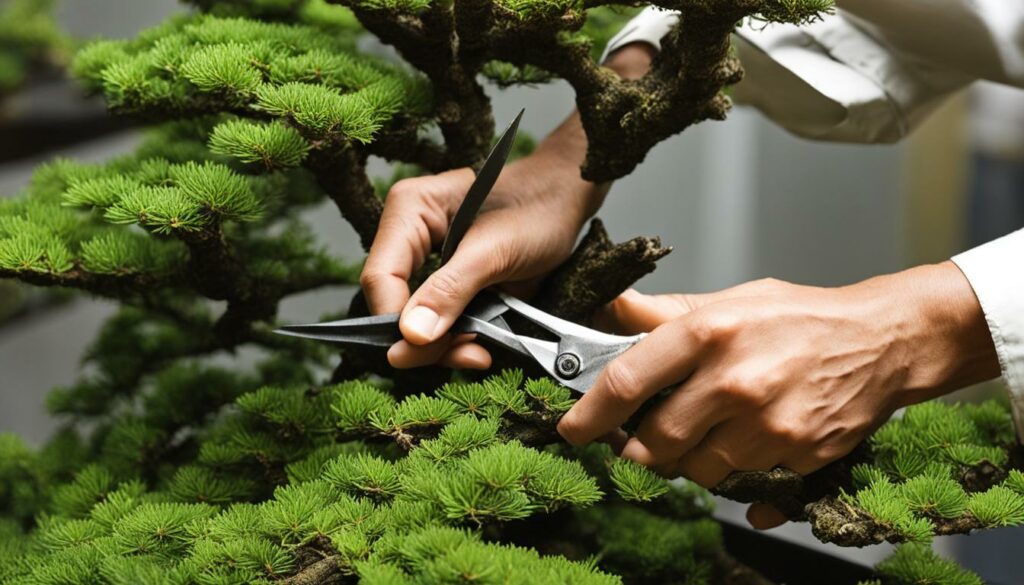
Avoiding Common Pruning Mistakes
Bonsai pruning is an essential technique for maintaining a healthy and aesthetically pleasing bonsai tree. However, beginners often make common mistakes that can harm the tree’s growth and overall health. By avoiding these mistakes, you can ensure your bonsai tree thrives for years to come.
Over-Pruning
One common mistake is over-pruning, which can stunt the tree’s growth and lead to an unbalanced shape. To avoid over-pruning, start with small snips and step back often to assess the tree’s overall appearance. Remember, it’s better to under-prune than over-prune.
Improper Branch Selection
Choosing the wrong branches to prune can also be detrimental to your bonsai tree’s health and shape. It’s important to select branches that complement the tree’s overall design and structure. Additionally, avoid cutting off too many branches at once, as this can shock the tree and slow its growth.
Neglecting Aftercare
After pruning your bonsai tree, it’s crucial to provide proper aftercare, including watering, fertilizing, and protecting from pests and diseases. Neglecting aftercare can undo all the benefits of your pruning efforts, leaving your tree vulnerable and weak.
By avoiding these common pruning mistakes and following proper pruning techniques and tree care, you can help your bonsai tree grow healthy and strong, and achieve the desired aesthetic look. Remember, bonsai pruning is an art form that requires patience and practice, but with diligence, you can master it.
Training and Shaping Techniques
Bonsai styling pruning is not just about trimming branches to keep your bonsai tree healthy, it is a form of art with various techniques to shape your tree according to your desired style. In this section, we will discuss additional techniques to train and shape your bonsai tree into the perfect masterpiece.
Clip and Grow
If you want to add movement or directional change to your tree’s stem or branch, the clip and grow technique is perfect for you. It is a technique that involves pruning to create a side branch that will grow in the direction of your choice. Here are the steps in performing this technique:
- Choose a branch that you want to bend and wire it using a training wire.
- Gently bend the branch to the desired direction.
- Clip the tip of the branch, leaving just enough bud that will grow in the direction you bent it.
- Allow the branch to grow, and once it reaches the desired length, remove the wire and reshape the branch.
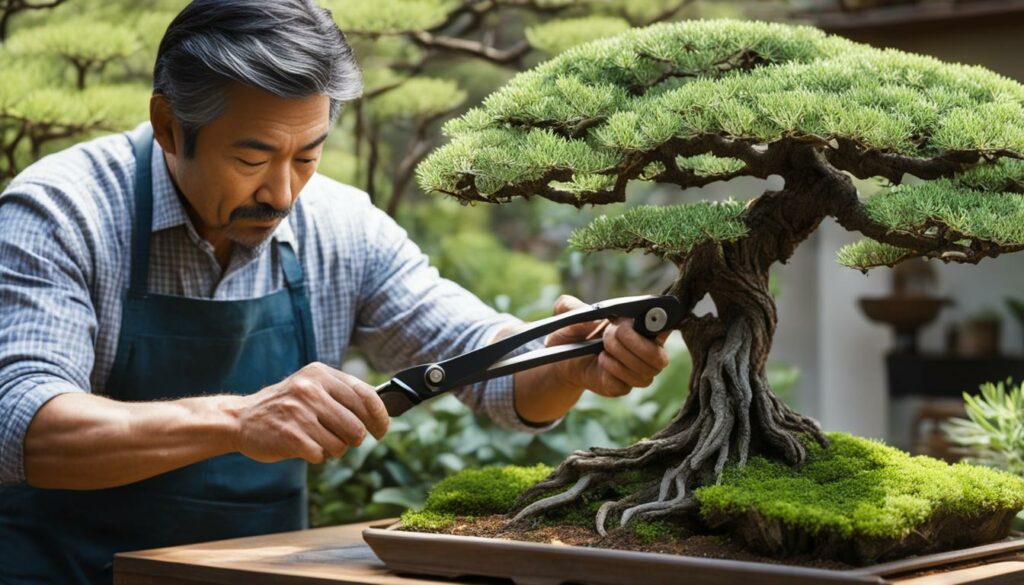
Pinching
Pinching is the process of removing new growth from the tips of your tree’s branches, which forces the tree’s energy to focus on the lower parts of the branch. This technique can help control the shape and density of your tree’s foliage. It also helps in balancing the growth of your tree.
Defoliation
Defoliation is a technique that removes all the leaves from your tree, which is usually done during the growing season. This technique is useful in promoting smaller and more compact leaves and encourages increased ramification. It also triggers the tree’s ability to produce new leaves that will replace the removed ones.
Advanced Bonsai Pruning Techniques
So, you’ve mastered the basics of bonsai pruning and are ready to take your skills to the next level. This section will explore advanced pruning techniques that will help you create unique and artistic effects in your bonsai trees. Read on to learn more about grafting, air layering, and jin/shari creation.
Grafting
Grafting is a technique used to combine a scion (a small twig or bud) from one tree with a rootstock from another tree. This technique is often used to create new varieties of plants or to repair damaged or weakened trees. In bonsai, grafting is used to create new branches, change the direction of growth, or produce a unique shape. The most common type of grafting used in bonsai is called thread grafting, which involves wrapping the scion around the rootstock to encourage fusion. Mastering this technique requires patience, precision, and a deep understanding of bonsai anatomy.
Air Layering
Air layering is a technique used to grow new roots on a branch of a tree while it is still attached to the parent plant. This technique is useful for thickening the trunk and creating new branches. To air layer a bonsai tree, simply make an incision in the bark, wrap the area in moss or other moisture-retaining material, and cover with a plastic bag. Over time, roots will start to grow in the moss, and once they are sufficiently developed, the branch can be cut and planted in its own pot.
Jin and Shari Creation
Jin and shari are two decorative techniques used to create the appearance of a dead wood bonsai tree. Jin refers to the stripping and bleaching of bark from branches to create a stubby, deadwood look. Shari, on the other hand, refers to the stripping of bark from the trunk of a tree to create a bare, deadwood section. These techniques are often used in bonsai to create the illusion of age or damage and to add character to the tree.
Remember that advanced pruning techniques should only be attempted after you have mastered the basics of bonsai pruning. These techniques require careful planning, precision, and patience, but the results can be truly spectacular.
Maintaining Pruned Bonsai Trees
Congratulations! You’ve successfully pruned your bonsai tree and achieved your desired shape and style. But your work is not over yet. Like any other plant, bonsai trees require proper care and maintenance to remain healthy and thriving. Here are some essential tips for keeping your pruned bonsai tree in tip-top shape:
Watering
Watering is one of the most critical aspects of caring for a bonsai tree. You must keep your tree adequately hydrated, but not overly watered. Overwatering can lead to root rot and other problems. To avoid this, make sure to water your tree thoroughly and then allow the topsoil to dry out slightly before watering again. The exact watering frequency depends on factors like climate, pot size, and tree species.
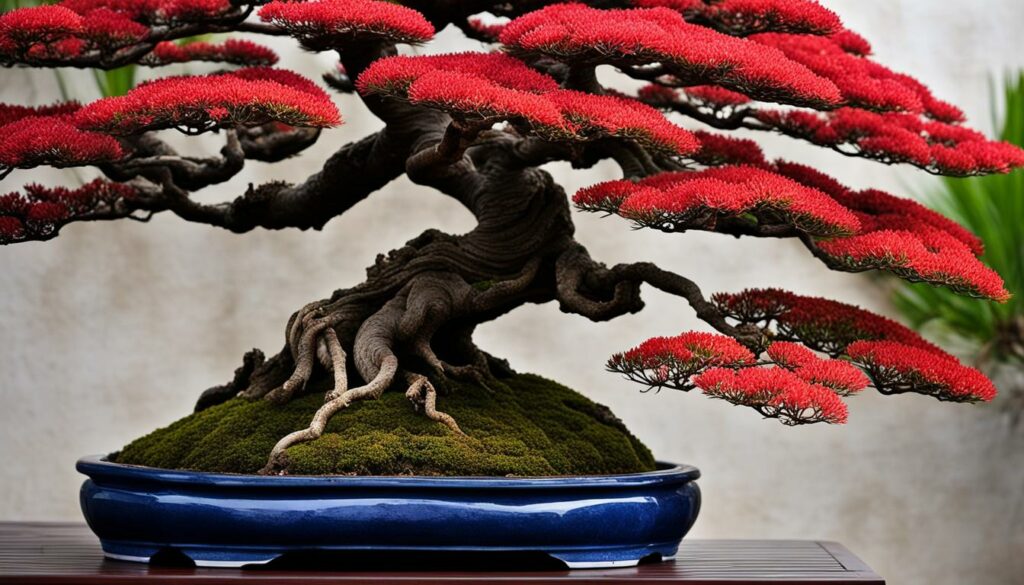
Fertilizing
Fertilizing is crucial for providing your bonsai tree with the nutrients it needs to thrive. You can use either liquid or slow-release fertilizers, or a combination of both. Make sure to follow the specific instructions on the fertilizer packaging and avoid over-fertilizing, as this can harm your tree.
Repotting
Repotting is another essential aspect of bonsai tree care. As your tree grows, it will require periodic repotting to provide fresh soil and room for the roots to expand. The frequency of repotting depends on factors like tree age, pot size, and soil quality. Generally, you should repot your bonsai tree every 2-3 years.
Trimming
Regular trimming is necessary to maintain the shape and size of your bonsai tree. After pruning, you must continue to trim your tree periodically to remove any new growth that detracts from the desired shape. Make clean, precise cuts to prevent damage or infection.
Pest and Disease Prevention
To keep your bonsai tree healthy, you must also take steps to prevent pests and diseases. This includes regular inspection for common pests like spider mites and aphids, as well as treating any signs of disease as soon as they appear. Good tree hygiene, such as keeping the foliage clean and removing any dead or diseased branches, can also help prevent problems.
By following these tips for maintaining your pruned bonsai tree, you can ensure that it remains healthy and beautiful for years to come.
Troubleshooting Bonsai Pruning Issues
Pruning is an essential practice in maintaining healthy bonsai trees. However, even with the best intentions and techniques, issues can arise that may affect the tree’s growth, esthetic appeal, and overall health. Fortunately, most issues can be addressed by applying appropriate solutions. In this section, we will discuss common problems that may arise during bonsai pruning and how to troubleshoot them.
Slow Growth
If your bonsai tree is not growing as expected, several factors may contribute to the problem. One likely cause is inadequate light or water. Ensure that your tree receives enough natural light or suitable artificial light sources, and water the tree thoroughly and regularly. Another possibility is root-related problems. Carefully examine the roots for signs of decay or rot, and improve soil aeration to promote healthy growth.
Branch Dieback
Branch dieback is a common problem in bonsai trees and can occur due to a lack of moisture, nutrient deficiencies, insect infestations, or fungal and bacterial diseases. Inspect the affected branches, remove any dead or damaged parts, and apply a suitable fungicide or insecticide to prevent further spread.
Pest Infestations
Various pests can harm your bonsai trees, such as spider mites, aphids, scale insects, and mealybugs. To prevent and control infestations, use a suitable insecticide and follow the recommended instructions when applying it. You can also remove pests manually using a soft brush or by washing the tree with soapy water.
| Issue | Cause | Solution |
|---|---|---|
| Slow Growth | Inadequate light and water, root problems | Provide adequate lighting and watering, inspect and improve soil and root health |
| Branch Dieback | Lack of moisture, nutrient deficiencies, infestations, diseases | Remove dead or damaged parts, apply a suitable fungicide or insecticide |
| Pest Infestations | Spider mites, aphids, scale insects, mealybugs | Use a suitable insecticide, manually remove pests, wash the tree with soapy water |
Overall, it is essential to address issues as soon as they arise to prevent further damage and maintain the health and vitality of your bonsai tree. Regular observation, maintenance, and care will help ensure that you enjoy the beauty and serenity of a well-maintained bonsai tree.
Conclusion
Congratulations on making it through this comprehensive guide on mastering the art of bonsai pruning! By now, you should have a solid understanding of bonsai styling pruning, its importance in shaping and maintaining a healthy bonsai tree, and the key techniques involved.
Remember, bonsai pruning is a crucial aspect of tree care that requires patience, practice, and attention to detail. By applying the pruning techniques covered in this article, you can create and maintain beautiful bonsai trees that reflect your unique style and personality.
To recap, some of the key concepts covered in this article include:
- The importance of bonsai styling pruning in shaping and maintaining a healthy bonsai tree
- The different pruning techniques used in bonsai tree care, including tip pruning, branch pruning, and root pruning
- The essential tools required for bonsai pruning, including shears, concave cutters, and wire cutters
- The delicate balance between promoting healthy growth and maintaining the desired shape through pruning
- The use of wiring and other techniques to achieve specific shapes and designs in bonsai trees
By following best practices for bonsai pruning and tree care, you can create stunning works of living art that bring joy and tranquility to your life. Don’t be afraid to experiment with different pruning techniques, and always remember to prioritize the health and well-being of your bonsai trees.
Thanks for reading, and happy pruning!
FAQ
What is bonsai pruning?
Bonsai pruning is a technique used to shape and maintain the size and aesthetics of a bonsai tree. It involves selectively removing branches, leaves, and roots to achieve a desired shape and promote healthy growth.
Why is bonsai pruning important?
Bonsai pruning is important for several reasons. It helps maintain the desired size and shape of the tree, improves airflow and light penetration, and promotes healthy growth. Pruning also allows the tree to develop a balanced branch structure and enhance its overall aesthetic appeal.
What tools do I need for bonsai pruning?
Some essential tools for bonsai pruning include shears, concave cutters, wire cutters, and branch pliers. These tools help you make precise cuts, remove unwanted branches, and shape the tree according to your desired style.
What are some common bonsai pruning techniques?
Common bonsai pruning techniques include tip pruning, branch pruning, and root pruning. Tip pruning involves removing the growing tips of branches to encourage back-budding and create a denser foliage. Branch pruning involves removing unwanted branches to improve the tree’s structure and balance. Root pruning helps control the tree’s size and promotes a healthy root system.
How do I place branches and foliage for styling pruning?
Branch and foliage placement is important for creating an aesthetically pleasing bonsai tree. You should aim to create movement, balance, and proportion in your tree’s design. Consider the tree’s natural growth patterns, and place branches and foliage accordingly to enhance its overall appearance.
How often should I prune my bonsai tree?
The frequency of pruning depends on the growth rate of your tree and the desired shape. Generally, most bonsai trees require pruning every few months or once a year. However, it is important to regularly observe your tree’s growth and adjust the pruning schedule accordingly.
Can I use wiring as a pruning technique?
Yes, wiring is often used in combination with pruning to shape and train bonsai trees. By wrapping wire around branches, you can guide their growth into desired positions. It is important to use appropriate wiring techniques and be careful not to damage the tree or restrict its circulation.
How does pruning contribute to the health of a bonsai tree?
Pruning plays a vital role in maintaining the health of a bonsai tree. It enhances airflow and light penetration, reduces pests and diseases, and promotes a strong root system. Proper pruning also stimulates new growth and helps the tree maintain a compact size suitable for its container.
Are there different pruning techniques for different seasons?
Yes, different seasons require different pruning techniques. Pruning during the dormant season, such as winter, focuses more on structural pruning. In spring and summer, you can perform maintenance pruning to control growth and maintain the desired shape. However, it’s important to research the specific needs of your tree species, as they may have different pruning requirements.
What are some common pruning mistakes to avoid?
Common pruning mistakes include over-pruning, removing too much foliage, improper branch selection, and neglecting aftercare. It’s important to follow proper pruning guidelines and techniques, observe the tree’s response, and provide appropriate care after pruning to avoid damaging the tree.
Are there advanced techniques for bonsai pruning?
Yes, there are advanced techniques for bonsai pruning, such as grafting, air layering, and jin/shari creation. These techniques are used to achieve unique and artistic effects in bonsai styling. They require a deeper understanding of bonsai care and should be approached with knowledge and caution.
How do I maintain a pruned bonsai tree?
Maintaining a pruned bonsai tree involves regular watering, fertilizing, repotting, and providing proper light conditions. You should also continue observing the tree’s growth and adjust the pruning as needed. Taking good care of your bonsai tree will help keep it healthy and thriving.
What should I do if I encounter pruning issues, such as slow growth or pest infestations?
If you encounter pruning issues like slow growth or pest infestations, it is important to identify the underlying cause. Slow growth may indicate improper pruning techniques or environmental factors. Pest infestations can be addressed through various methods, including biological controls and targeted insecticides. It is best to seek advice from experienced bonsai enthusiasts or professionals for specific troubleshooting guidance.
